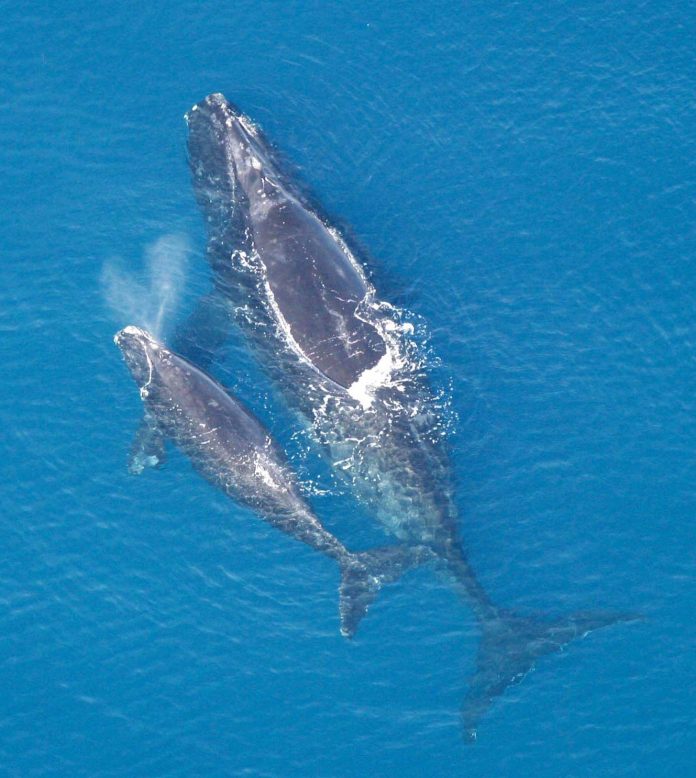By Diana Furchtgott-Roth
When wind turbine companies seek permission to harm sea life, reporters for The Associated Press blame The Heritage Foundation (where I work) and The Heartland Institute, instead of reporting the facts.
It was a Chico Marx moment: “Who ya gonna believe, me or your own eyes?
The misleading AP article—carried by WBTS-TV in Boston; The Daily Star newspaper of Oneonta, N.Y.; and WTFX-TV in Philadelphia, among others—stated that “scientists say there is no credible evidence linking offshore wind farms to whale deaths” and that “offshore wind opponents are using unsupported claims about harm to whales to try to stop projects, with some of the loudest opposition centered in New Jersey.”
The article accuses opponents of causing “angst in coastal communities, where developers need to build shoreside infrastructure to operate a wind farm.”
If so, why are offshore wind farm companies asking Uncle Sam for permission to harm ocean mammals, and why are dead whales washing up on East Coast beaches?
According to AP reporters Christina Larson, Jennifer McDermott, Patrick Whittle and Wayne Parry, “One vocal opponent of offshore wind is The Heritage Foundation, a conservative think tank based in Washington, D.C. Diana Furchtgott-Roth, director of the foundation’s center for energy, climate and environment, wrote in November that Danish company Ørsted’s scrapped New Jersey wind project was “unsightly” and “a threat to wildlife.” (The Daily Signal is the news outlet of The Heritage Foundation.)
If the four reporters had done their homework, they would have mentioned that in required environmental-impact filings with the National Oceanic and Atmospheric Administration, companies explain that sounds generated by their activities will harm ocean mammals.
For example, Atlantic Shores and Ørsted’s Ocean Winds both requested permission to harm ocean mammals in their applications for New Jersey offshore-wind projects. And, since boats ramped up offshore surveys in May 2022, 31 dead whales have washed up on New Jersey and surrounding beaches.
Ørsted, which in November pulled out of a proposed New Jersey offshore wind farm, requested permission to harm 30 whales, 3,231 dolphins, 82 porpoises, and eight seals through sound waves generated by its surveys—although the company claims that the damage would be negligible.
The precise numbers and detailed species can be found on the website of the NOAA, in Ørsted’s Application for Incidental Harassment Authorization (Table 9).
Atlantic Shores, owned by Dutch Shell oil and French EDF, is still seeking permission to locate an offshore wind farm in New Jersey. In its Request for Incidental Harassment (Table 6-3) it stated that acoustic waves associated with the siting of the wind turbines would likely affect 10 whales, 662 dolphins, 206 porpoises, and 546 seals (also termed a negligible amount). It received permission to harm these marine animals.
Although the companies describe effects as “negligible,” the NOAA website states that it’s difficult to measure the effects of manmade sounds on mammals.
“Acoustic trauma, which could result from close exposure to loud human-produced sounds, is very challenging to assess, particularly with any amount of decomposition,” or damage to the whale’s body, states NOAA on its website.
Sean Hayes, chief of protected species for the NOAA, wrote in a letter to Brian Hooker, lead biologist at the Bureau of Ocean Energy Management: “The development of offshore wind poses risks to these species [right whales], which is magnified in southern New England waters due to species abundance and distribution … . However, unlike vessel traffic and noise, which can be mitigated to some extent, oceanographic impacts from installed and operating turbines cannot be mitigated for the 30-year life span of the project, unless they are decommissioned.”
In addition, the AP article made no mention that some of the companies that would install these wind farms are owned by Denmark, the Netherlands and France—despite the fact that renewable energy tax credits in the so-called Inflation Reduction Act are aimed at stimulating domestic firms to produce renewable energy. And there was no mention that New Jersey offshore wind farms would have practically no effect on mitigating global temperatures, either now or by 2100.
Local municipalities are increasingly rejecting wind farms, according to a Renewable Rejections Database tracker maintained by environmental scholar Robert Bryce. He reports that 417 wind farms and 190 solar arrays have been rejected by local communities in 2023. More than 600 projects have been rejected in 2023, up from 489 in 2022 and 208 in 2018.
Proponents of renewable energy are trying to gloss over its harms and exaggerate its benefits in an attempt to push costly offshore wind farms. For the record, French- and Dutch-owned Atlantic Shores and Danish-owned Ørsted asked permission to hurt whales, dolphins, porpoises and seals.
Americans in New Jersey and elsewhere oppose that environmental damage.
Diana Furchtgott-Roth is the director of the Center for Energy, Climate and Environment and the Herbert and Joyce Morgan Fellow at The Heritage Foundation.
Originally published by The Daily Signal. Republished with permission.
For more on offshore wind’s impact on the North Atlantic Right Whale, click here.
For more on endangered species, click here.



























Several years ago I wrote an article (I’m a retired journalist) on Duke Energy’s agreement to allow its land-based wind farms to kill thousands of birds including protected species such as owls, hawks and Bald Eagles. if someone purposely killed a Bald Eagle, they would be fined. But Duke Energy can kill thousands of birds without any penalty because using “renewable” forms of energy is for the greater good, and killing birds just collateral damage.
In Arizona, there is a huge solar farm west of Yuma, AZ, that I drive past when I visit Southern California. The acres of solar panels that cover the desert are also dangerous to birds, especially if they fly low over the mirrored panels. Workers at the solar farm find dead birds all over the place! They jokingly call them “fry babies” — terrible! Where are the environmentalists when you need them??